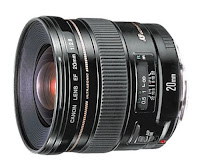
Canon wide-angle lenses are lenses with focal lengths below 50mm. The shorter the focal length, the wider the lens becomes and your field of view will be bigger. Simply put, if you stood in the same position, a Canon wide-angle lens can accurately squeeze more into the photo. This is particularly useful if you are trying to take a photograph of a large building from inside or out, an immense landscape view, or a group shot. These lenses are very useful when you cannot step back any further to take the photograph.
As you may expect, Canon wide-angle lenses have a greater distortion due to squeezing more into your photos. This distortion is especially evident toward the edges of the photo. On natural landscapes, this may not be that noticeable, but can appear unappealing on portrait shots unless the subject is placed directly in the middle of the frame. With that being said, this effect can produce pleasing results and be used to amplify perspective. I suggest getting as close to the foreground subject as possible so that it appears large in comparison to the background. Canon wide-angle lenses have large depths of field, which means that it is easier to get lots in well-defined focus from close-up to far away.
The most common wide-angle focal length that produces natural-looking results is the 28mm. In general, focal lengths below 20mm are known as ultra-wide-angle and can produce extreme results. I would have to say that the fish-eye lenses deliver the most extreme results as they produce a highly curved result, while capturing an extremely significant field of view.
As you may expect, Canon wide-angle lenses have a greater distortion due to squeezing more into your photos. This distortion is especially evident toward the edges of the photo. On natural landscapes, this may not be that noticeable, but can appear unappealing on portrait shots unless the subject is placed directly in the middle of the frame. With that being said, this effect can produce pleasing results and be used to amplify perspective. I suggest getting as close to the foreground subject as possible so that it appears large in comparison to the background. Canon wide-angle lenses have large depths of field, which means that it is easier to get lots in well-defined focus from close-up to far away.
The most common wide-angle focal length that produces natural-looking results is the 28mm. In general, focal lengths below 20mm are known as ultra-wide-angle and can produce extreme results. I would have to say that the fish-eye lenses deliver the most extreme results as they produce a highly curved result, while capturing an extremely significant field of view.
When choosing a lens, it is important to keep in mind any reduction in field that would be caused by your DSLRs sensor. Canon’s APS-C models such as the EOS 400D/XTi and 40D both have a reduction factor of 1.6x. As a result, if you want 28mm equivalent coverage, you will need to fit them with an 18mm lens.
Canon wide-angle lenses can add a lot of enjoyment and provide methods to enhance your photo taking abilities in ways you have never experienced. So what are you waiting for? Pick up your Canon wide-angle lens today!
No comments:
Post a Comment